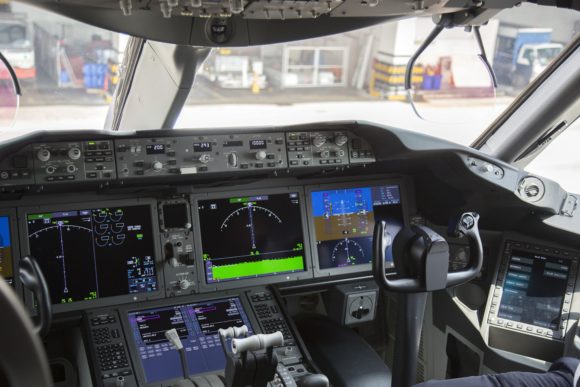Boeing Co. has slowed deliveries of its 787 Dreamliner as crews check for a new manufacturing flaw involving gaps in the horizontal stabilizer, the small wing in the aircraft tail.
The company also is inspecting newly built Dreamliners for slight folds or roughness on the lining of the carbon-composite fuselage, an issue that came to light late last month when Boeing told 787 operators to ground eight of the jets. In both instances, any variation that is greater than 0.005 inch — about the thickness of a human hair — is beyond the maximum allowable gap.
“We are taking time to thoroughly inspect completed 787s to ensure that they are free of the issues and meet all engineering specifications prior to delivery,” Boeing said in an email Tuesday. “We expect these inspections to affect the timing of 787 deliveries in the near-term.”
The delivery slowdown further batters Boeing’s reputation as the Chicago-based planemaker works with regulators to end the worldwide grounding of a separate model, the 737 Max. That aircraft has been out of service for almost 18 months after two crashes killed 346 people. In the case of the new structural fault on the 787, Boeing’s engineers have “determined that this is not an immediate safety of flight issue,” the company said.
“We are correcting the issue on airplanes that have not been delivered,” Boeing said. “Analysis is underway to determine if action is required on the in-service fleet.”
The shares fell 3.6% to $164.91 at 12:28 p.m. in New York. Boeing tumbled 47% this year through Sept. 4, the biggest decline on the Dow Jones Industrial Average.
The Federal Aviation Administration said it is probing the 787 manufacturing flaws. “The agency continues to engage with Boeing. It is too early to speculate about the nature or extent of any proposed Airworthiness Directives that might arise from the agency’s investigation,” the FAA said.
The FAA is already seeking multiple civil penalties against Boeing for issues including alleged undue pressure on workers who raised safety issues. The company also agreed to pay $12 million in 2015 to settle multiple charges that involved lapses in manufacturing, including at the South Carolina facility where some of the 787s are produced.
Boeing earlier identified two manufacturing issues where workers at its South Carolina factory mated two fuselage barrels at the rear of the aircraft. The joiners, known as shims, weren’t as wide as the gap they were supposed to fill but were within engineering tolerance — the allowable margin for variation. But on a small batch of aircraft, the improperly sized shims rubbed up against roughness in the inner lining.
Aerodynamic Loads
The two issues combined were determined to weaken the carbon hulls so that they might not withstand the highest loads the aircraft could encounter in fight. All eight of the aircraft taken out of service for inspection and repairs were delivered last year, said a person familiar with the matter.
Boeing has determined that the latest issue wouldn’t immediately compromise the 787 horizontal stabilizer’s ability to withstand maximum aerodynamic loads, said the person, who asked not to be identified as the deliberations are confidential. Company engineers are doing a final analysis to determine whether the production flaws may lead to premature aging.
“It is not an immediate safety of flight issue as none of the airplanes in service are within a window where they would begin to experience this aging,” Boeing said.
The manufacturer delivered four 787s in August and 13 aircraft in total, according to data published on its website. The company also booked eight new orders, five of which were for the grounded Max. The planemaker recorded another 20 order cancellations in the month, including 17 Max jets.
Was this article valuable?
Here are more articles you may enjoy.


 State Farm Sued Over Policies Backed by Distressed Insurer PHL
State Farm Sued Over Policies Backed by Distressed Insurer PHL  Asahi Sales Drop Worsens as Cyber Hack Disruption Lingers
Asahi Sales Drop Worsens as Cyber Hack Disruption Lingers  How Three New CMS Policies Impact Workers’ Comp Claims
How Three New CMS Policies Impact Workers’ Comp Claims  Standard Chartered Settles $2 Billion Iranian Sanction Suit in London
Standard Chartered Settles $2 Billion Iranian Sanction Suit in London 